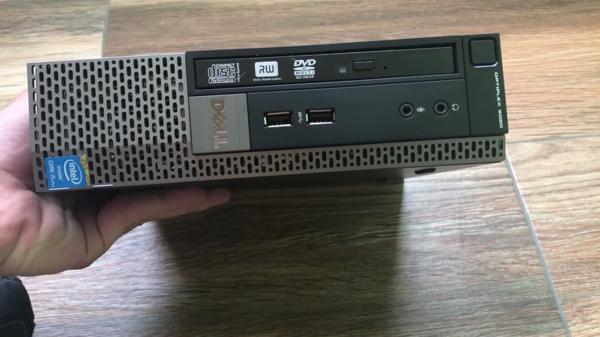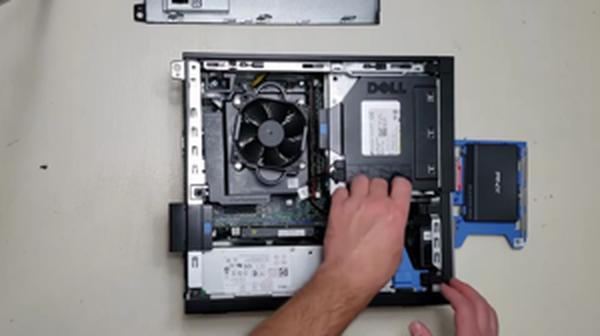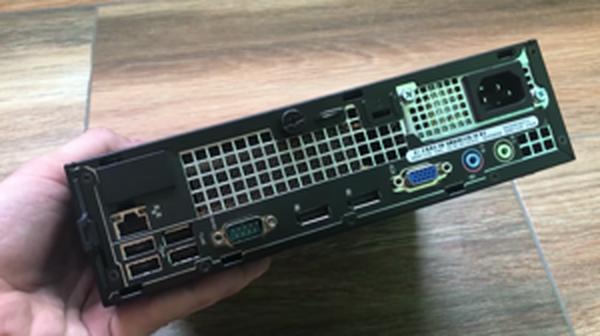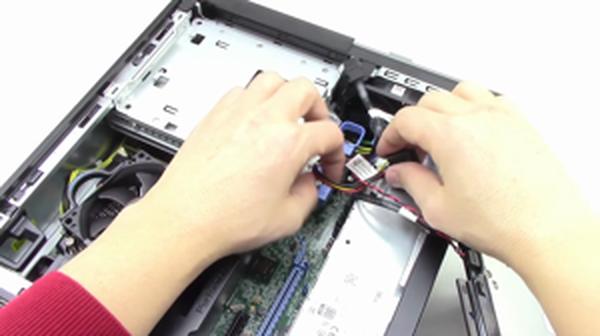Dell Optiplex 9020 SFF Desktop: my take on working with this small pc
Introduction
I have been trying out refurbished desktops, one of which being the the Dell Optiplex 9020 SFF. Initially, I was skeptical about how a small form factor PC like this would hold up to my daily tasks - but it performs quite well. Below is my take on what this compact powerhouse has to offer for those who tread the line between cost-efficiency and functionality.
Initial Impressions and Setup Experience

Navigating my initial setup with the Dell Optiplex 9020 SFF Desktop was almost like unwrapping a surprise gift you didn't expect to be as good as it is. First impressions? The machine looked immaculate – nary a scratch to indicate its refurbished nature. It booted up swiftly, which speaks volumes about the SSD upgrade that's been done on it. I'm not the savviest when it comes to tech, but I appreciate user-friendly experiences, and this was certainly one.
I hit a couple of snags initially, chief among them being the Microsoft Dropbox sync issue that had me scrambling to delete the app just to keep my old data from flooding in. It’s worth noting though that this is more of a Microsoft issue than anything to do with the vendor or the hardware itself. I do wish the machine had an HDMI port – DisplayPort is fine, but HDMI is ubiquitous, and not having one seems like an oversight.
I also noticed the hyperthreading was disabled during a quick dive into the BIOS, something I wouldn't normally venture into, but a curiosity peek at the Task Manager had me wondering why I was only seeing four logical processors instead of eight. A simple toggle in the BIOS and I was good to go – a simple fix, but something a less confident user might not catch or know how to handle.
Speaking of things I wish were slightly better, setting up the sound was more of a hassle than I'd like. The instructions felt like trying to read a newspaper through binoculars – too small and far too vague. A clearer, more detailed guide would've been a boon, especially since I wanted to get the most out of my media experience with an additional soundbar.
What I appreciated was the goodness packed into the $200 price tag. The system included all the necessary accessories – wired USB keyboard, mouse, USB Wi-Fi dongle, and even an HDMI extender. And despite the optical drive seeming like a nostalgic inclusion, it's still a nice touch.
Upon firing up, I was greeted with Windows 10 Pro, albeit a very outdated version. I immediately upgraded to the latest Windows 10 build and, bitten by the curiosity bug, decided to dual-boot with Xubuntu 22.04LTS. I'm always tinkering, so the ability to bypass the requirements for Windows 11 Pro and get it running was a hacker’s delight (though, I must point out, it isn't for the faint of heart or those without technical know-how).
The desktop hasn’t faltered under various tasks, from basic document editing to heavy Excel file maneuvering. It boots fast, and the performance, thus far, is more than satisfactory for my non-gaming needs. The lack of Windows 11 compatibility out-of-the-box due to an outdated processor is a bummer, but not unexpected given its age.
While the missing Wi-Fi was initially a head-scratcher and the seller’s communication could be snappier, the quick resolve provided was commendable. Another point of contention was the pre-loaded bloatware, a pesky nuisance, especially when dealing with adware right off the bat. This, combined with the bare minimum power supply that makes significant upgrading tricky, are points potential buyers need to be aware of.
In summary, this compact dell delivers more than what one might anticipate at such a price point, despite some room for improvement, particularly in terms of ease of use for the less tech-inclined.
Performance and Upgradeability

The compact form factor of the Dell Optiplex 9020 SFF Desktop can be misleading: you might not expect much in terms of performance, but I was pleasantly surprised. With a 4th generation Intel Core i7-4770 processor and the option to boost RAM up to 32GB, plus a 1TB SSD, this machine boots in seconds and handles multiple tasks with ease. Crucially, for anyone thinking about future-proofing or using the device for demanding applications, these specs mean that the desktop can cope with a wide range of functions, from day-to-day productivity to more memory-intensive processes.
However, upgradeability is a mixed bag here. While I was able to increase the memory and swap out the SSD, there are limitations intrinsic to the small form factor. For example, you won’t be fitting a high-end graphics card in here; there simply isn’t the space or the sufficient power supply to support it. This is underscored by the onboard Intel HD Graphics 4600, which struggles with current Adobe Photoshop versions requiring DirectX 12.0, as they demand a discrete GPU. A server-grade error-correcting code (ECC) memory isn't supported either, which might be a drawback for certain professional applications that could benefit from this extra data integrity.
One modification that’s a notable improvement is enabling hyperthreading through the BIOS to recognize 8 logical processors instead of just 4. It’s an extensive boost, particularly for multithreading applications. However, it’s important to be aware that some units arrive with hyperthreading disabled, which means you’ll need to dive into the BIOS settings to change this—a simple step for those who are tech-savvy, but potentially daunting for novices.
Network connectivity initially presented a small hiccup, as I found the machine didn’t have built-in WiFi as some might expect. This was quickly remedied with the included USB WiFi dongle. For those who prefer a more integrated approach or need stronger signal capabilities, there might be a need to explore aftermarket solutions to find a more robust wireless option.
While the default installed operating system is a 'very old' Windows 10 Pro, I was able to perform a dual-boot installation with Xubuntu 22.04LTS and then upgrade to Windows 11 Pro by bypassing the Secure Boot, TPM, and modern CPU generation requirements. For those interested in building and configuring their own systems, you might find Building your own deep learning machine in 2023: some reflections insightful. This process, while effective, highlights another limitation—Windows 11 will not natively support this machine, possibly due to the older i7 processor not meeting the newer OS requirements, which is something to consider if you want to stay updated with the latest from Microsoft.
In summary, the Dell Optiplex 9020 SFF Desktop is an impressive performer that’s great for basic to moderate computing needs, but has limitations when it comes to upgrades. If your computing demands are likely to escalate, or you require cutting-edge software compatibility and graphics performance, it may not be the best investment. However, for many scenarios such as programming, general multitasking, and day-to-day use, it’s an excellent and cost-efficient choice that’s also surprisingly robust for its size.
Gaming and Graphics Capabilities

As someone who dabbles in gaming and occasionally delves into graphic design, the Dell Optiplex 9020 SFF initially raised some concerns for me - but also pleasantly surprised me. We all know that massive, LED-lit towers with water cooling systems are the stereotypical gaming rigs. But what about the small form factor (SFF) PCs? Initially, I was skeptical about this desktop's gaming and graphics capabilities, especially given its integrated Intel HD Graphics 4600.
Now, straight off the bat, we've got to acknowledge that the 4600 isn't built for high-end gaming or intensive graphic design. It supports DirectX 11, but the latest games and software like Photoshop 2024 require DirectX 12.0, which is a fundamental mismatch. Adobe's own system requirements clearly outline the need for DirectX 12 compatibility for optimal performance - so if you're working with current-gen software, you'll hit a wall.
Yet, the machine pleasantly surprises for less intense tasks. Older games run smoothly, and less demanding graphic design work is perfectly doable. I've managed to run indie games and classics without much fuss, and basic video editing is a breeze. It's not about throwing the most pixels on a screen; it's about running the software that suits your needs and hardware. And for someone whose gaming isn't their lifeblood but a casual pursuit, the Optiplex 9020 fits like a snug glove.
However, I must admit that the unavailability of an HDMI port is perplexing and restrictive. You'd need a DisplayPort to HDMI adapter for modern monitors, which is an additional expense and a point of failure. Also, without a dedicated GPU, you're missing out on a massive chunk of gaming and high-def streaming potential. Remember, this PC can't naturally push out 4K content to your Ultra HD display, which is virtually a basic expectation these days.
For resource-light photo editing and office tasks, though, the desktop is quite capable. I've also seen instances in community forums like Reddit where users have successfully added low-profile GPUs to similar SFF systems, hinting at upgradeability. But keep in mind, the power supply in the Optiplex is conservative, and adding a beefy graphics card could create new bottlenecks - you'd have to balance power draw with any additional hardware.
In summary, the Dell Optiplex 9020 SFF is a seasoned fighter in a light gaming and graphics match but would be outclassed in a heavyweight bout. It packs a punch for its size, with the caveat that it might be necessary to play within the confines of older or less demanding software. The absence of features like TPM may impact your future upgrade path to newer operating systems, which is something you should factor into your purchase decision. For the price and form factor, it's a commendable machine, but temper your expectations if cutting-edge gaming and high-end graphics work are on your daily roster.
Overall Value and Longevity

Reflecting on my time with the Dell Optiplex 9020 SFF Desktop, I have to say it's been something of a mixed bag, but nonetheless leans on the positive side, especially when considering value and the financial outlay. At roughly $200, I was wary of what a machine like this could offer, especially when you’re treading in the waters of refurbished tech.
The initial setup was a breeze, with the machine booting up quickly and Windows 10 Pro installed. I appreciated that the previous users had highlighted the necessity to enable hyperthreading in BIOS to unlock the full potential of the CPU which now reflects 4 cores and 8 threads, showcasing that even such a small misstep can be corrected with a bit of technical know-how.
On the flip side, the system's refusal to accept my old Microsoft Dropbox and a lack of comprehensive setup instructions for supplementary peripherals like a soundbar was a tad frustrating. Even so, the process remained largely plug-and-play, which is more than I can say for some newer, more complex systems.
From a technical standpoint, current specs like 32 GB RAM and a 1 TB SSD are impressive in a refurbished unit. For everyday tasks and business requirements, this machine does what you'd expect without skipping a beat. I found it quick in operation, and for the more Linux-inclined, the ease of setting up a dual boot with Xubuntu was a breath of fresh air.
However, it's not all smooth sailing. Running contemporary versions of Adobe Photoshop or upgrading to Windows 11 Pro might prove to be sticking points due to hardware limitations like the GPU and processor generation. That said, I found workarounds such as installing older versions of software or, as some have done, bypassing Win11's stringent requirements.
The longevity of this machine is somewhat of a concern as well, with Microsoft's support for Windows 10 set to end in 2025, potentially rendering this system obsolete for Windows users. Although, the Linux community gleefully opens its arms to hardware like this, with distributions likely to support it for years beyond that deadline.
In terms of durability, I expected hiccups with refurbished machines, but this unit proved reliable. A power supply failure here and a hard drive issue there are par for the course, yet they are not as prevalent as one might fear. Extending the warranty is something I'd recommend, as hardware failures—while infrequent—can be a hassle, particularly if the system finds a place in a business setting or a crucial home office environment.
The world of second-hand tech can be daunting, but Dell's refurbished Optiplex 9020 is a testament to how viable it can be for those seeking a cost-effective solution without the need for cutting-edge performance. It excels in standard computational tasks and delivers unexpected swiftness in daily use, which is quite satisfying for a seasoned tech user like me. My advice? Understand the specs, know your requirements, and if they align, don't hesitate to consider this as a seriously good value proposition. For reference on Dell Optiplex systems, you can explore more about specs and models through Dell’s Official Website. As for curious tinkerers and developers, rummaging through information on community-driven platforms like GitHub can offer additional insights into making the most of systems like these.
Share